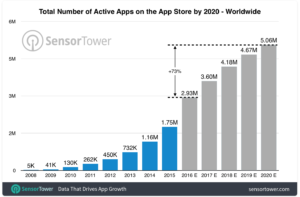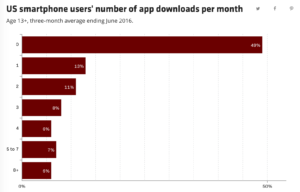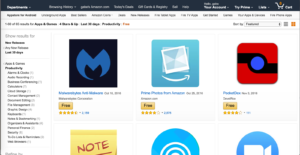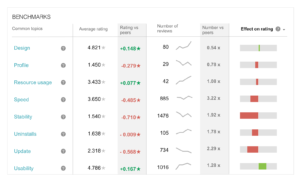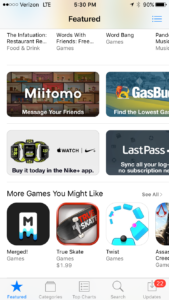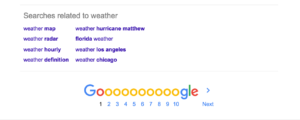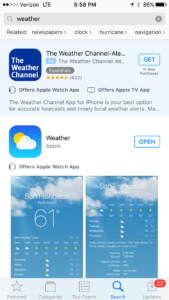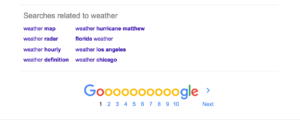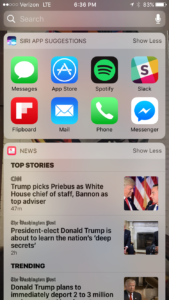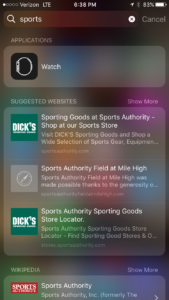App discovery is broken.
That’s a statement many app users, developers and marketers could all agree with. While the number of apps to choose from (or compete with) has exploded since the inception of the App Store and Play Store in 2008, Apple and Google have failed to make continuous progress in improving app discovery since, leading to about half of smartphone owners neglecting to download even a single app.
Graph from Sensor Tower: The App Store in Four Years: 5 Million apps by 2020
Graph from Recode article (Comscore data): Half of U.S smartphone users download zero apps per month.
With annual growth in smartphone users cooling off (per Gartner research growth was 7% in 2016 vs 73% in 2010) and spend per mobile user increasing (per a recent App Annie Webinar, ad spend per user will rise from ~$40 in 2016 to ~$50 in 2018), the need to improve user satisfaction with app discovery, and thus downloads, is the clear App Store priority.
Without tackling this priority, developers face decreased return on investment per user and ultimately a stagnation of app development and divestment from the app industry at-large. If not immediately addressed, this fundamental problem of app discovery may very well have the knock-on effect of diminishing growth from exciting emerging mobile technologies, such as Virtual Reality and Augmented Reality.
This article identifies three main categories of actions that can help fix the problem of app discovery, and in doing so boost the number of users downloading apps for a first time, as well as those returning for more:
- Improving the user experience of the App Store and Play Store.
- Tweaking the keyword ranking algorithms for better results.
- Encouraging discovery outside the App Store apps.
Improving the User Experience of the App Store and Play Store
The App Store and Play Store Apps together are the single most important component of the app discovery experience in need of improvement. Making the act of sifting through apps easier and more enjoyable would go a long ways to increasing user participation. Google has made more progress than Apple in this regard, with Apple’s app looking largely the same since 2008. (iOS 7 in 2012 pictured below). Yet, both apps certainly have more work to be done.
Image Credit: imore.com
Creating top charts and segmenting apps into categories, each with their own top lists, were two inventive ideas. But, neither store has yet to provide filtering options. There is currently no option to, say, filter the results for non-games, apps rated 4 stars or higher all-time, or apps that have been updated to support the latest OS. Both stores should take a page out of the Amazon Appstore’s book, which allows users to filter results by aspects such as ratings, price or latest release date, as well as modify the results sorting by relevance, “featured,” price, or average customer review.
Image Credit: Amazon Appstore
Looking to the very apps they promote can also yield opportunities for improvements in the App/Play store apps. For example, one of Spotify’s best features is the ability of users to create searchable, user-curated lists of music. Why not extend this ability to App Store users? A move that could boost engagement from users who like to curate lists, and also a way to boost intrigue with all users by tapping into the social benefits of P2P-style list curation.
Making the App/Play Store apps richer and more visually engaging could help, too. Take, for example, Apple’s trending searches, which is the first screen that a user lands on after navigating to search. Yet, it is not visual, does not provide history of trends or even a data point to differentiate the magnitude of trends (like Twitter trends); Apple could show a search popularity index number for each trend at the least. Apple could also utilize its own technology in its most important app, such as enabling force touching on the main navigation buttons to reveal more options. Additionally, Apple and Google could provide support for GIFs. Videos were a good touch, but in actuality most people don’t watch them (per Store Maven data, only 7% of iOS users and 15% of Android users watch videos). GIFs convey more information than a screenshot, at a fraction of the time commitment required to watch a video.
Next, consider how little consistency there is in the process (or rather grind) of app discovery. App ratings and categories are the main levers of consistency of content; screenshots, icons and descriptions are all consistent in form, yet developers utilize them with far-ranging diversity, meaning that users must expend more effort in attempting to figure out what each app is about. Users are forced to take random stabs at apps based on their icons, titles, ratings, or first 2 screenshots, followed by analyzing the screenshots, reviews and description in order to figure out whether that one app solves a problem they have, or offers value otherwise.
Apple and Google should provide a more consistent method for app content to quickly convey what an app offers, in a browsable, searchable and filterable manner. Developers can think of this as a hybrid between keywords and categories, which would allow users to find apps that contain certain features(e.g. social sharing, 3D touch-enabled or level-based) or content (e.g. business, travel or health-oriented). By making this a field that developers could enter information into in a canonical format (i.e. boolean), users could enjoy consistency in the content they use to discover apps, and thus save them time and increase their satisfaction.
Further expanding on this notion of consistency, the stores should allow apps to provide more information relevant for the type of user to whom they are selling. Games could showcase more than one video, or provide special screenshots for levels or multiplayer mode if applicable. E-commerce, financial, health and education apps could provide notes on the technology they are equipped with (e.g. Apple/Android Pay) or regulations on data by which they abide.
Expanded reviews should be a part of the App Store revamp as well. A simple 5-star rating is old-school these days, and about as descriptive as a thumbs up or thumbs down. Users should be able to score apps based on characteristics such as stability, features or customer support. Only users who wish to leave an expanded review would be required to do so, just as only users who wish to leave a review in addition to a rating - many of whom do, and many of whom already provide this deeper insight unbidden, through their reviews. At any rate, Google already analyzes reviews to extract this information for developers, so why not allow users who want to give advanced feedback the chance, and make it available to all users to benefit from?
Image Credit: Android Developer’s Blog
Featuring certain apps is a great idea that didn’t exist for websites. Dangling the “featured status” carrot not only entices developers to implement best practices and focus on user satisfaction, it also gives users an easy option to discover new, quality apps. Yet, the number of features has inflated and caused a devaluation of the feature status, as well as overwhelming users with hundreds of featured lists, all purporting to be apps they should like. It seems Google and Apple forgot that mobile devices have limited space and carriers have taken to overcharging for data. To restore the utility of featured app sections, the stores should cut back on the number of features. The reduced list could include a mix of types of features, including some constant themes (e.g. best new or editor’s choice) and some variable themes (e.g. holidays or best educational apps).
Here is a prime example of how overwhelming the featured sections can be. Apple lists MORE games we might like, on top of the NEW games we already don’t have enough time to enjoy.
Lastly, adding a send feedback option in app results (across search, category and featured UIs) could be a good move in boosting user satisfaction. Crunching big, quantitative data is great, but direct user feedback is always necessary to make the best possible version of a product, and the App and Play Store apps are no exception. Google even employs an easily visible feedback option in its web search UI, yet neglects to extend the same to Play Store users. Moreover, Apple should follow Google’s lead in allowing developers to reply to user reviews – this is another excellent way to boost both developer and user satisfaction, given users could see their concerns directly addressed, rather than left wondering whether their feedback has disappeared into the ether.
Tweaking the Keyword Ranking Algorithms for Better Results
App discovery departs from website discovery in many ways; some good (e.g. centralized, safer distribution, reviews, categorization, top charts) and some not so good. Case in point, paid downloads influence organic rankings for both category and keywords. This is a very significant and unfortunate break from the precedent set in website indexing, where SEO keyword rankings are not influenced by PPC clicks. To keep quality and diversity of apps high, stores must find a way to crack down on efforts to game the ranking system, which favor spammers and give an unfair advantage to deep pocketed apps, each of which squeezes legitimate independent or medium-sized developers and suppresses fair competition and innovation.
Three of the biggest offenses to maintaining ranking legitimacy include category burst install campaigns (where users download via an app’s direct link), keyword burst install campaigns (where users search a keyword and download a specific app) and paid reviews (where users leave 5 star reviews for an app). Each is customized to manipulate an app’s ranking by targeting vulnerabilities in the ranking algorithms. Category burst campaigns increase an app’s category rank, while keyword-specific burst campaigns boost rank for a targeted keyword. Paid reviews mainly increase an app’s conversion rate, but can also boost its keyword rankings. All work by driving a massive volume of downloads or reviews in a very short time frame, which produces highly effective results given that the app ranking algorithms reward apps that have high download/review velocity with higher rankings. Google has already promised to crack down on these manipulation efforts, and Apple should follow suit.
In order to reduce manipulation efforts, Apple and Google should weigh factors higher that are more expensive, and thus more difficult to tamper with:
- Increases in an app’s retention rate over time. This wouldn’t be a massive change as the algorithms already use this signal to some degree. Apple and Google already provide this data to developers, and, in fact, Google has recently begun to surface benchmark conversion rates for an app’s category. While this would favor existing apps, it would provide a service for users and is not beyond precedent, given that age is a positive signal for websites. New and popular apps would not be penalized, given they could still be placed in the trending search results and top charts.
- Introduce brand new signals. Page-rank was Google’s genius invention that revolutionized search; something similar could benefit app discovery as deep-linking technology grows and a record of connectivity between apps grows. The act of installing is also unique to apps and could possibly yield some form of additional signal.
- Quality updates should be encouraged, not ignored or even discouraged (i.e. resetting ratings for iOS). Apps should receive better ranking strength for maintaining and expanding the value they provide to users; yet it would be important to ensure updates are not simply the same code with minimal tweaks. Perhaps reviewers could be empowered to discern quality from minimal or fake updates and assign a sort of update score.
- Randomly test boosted keyword rankings for all apps. Apps with the highest comparative retention numbers should be randomly boosted to the #1 position for 1% of traffic. This offers a fair chance for any app to climb the rankings, even if they are not driving massive download or review volumes.
Users should also be encouraged to be more original in their searches, which would lead to more long-tail, descriptive keywords, which could in turn help users find better apps. Given that half of App Store searches are app names, this is one more indicator that app discovery is broken. It proves that people are not using search to discover, but rather to find apps they already know of (the equivalent of using a direct link).
One easy way to accomplish this is would be to reduce the number of autofill results that are branded (app names). When users’ screens are filled with app names, they are less likely to continue typing their keywords in, opting instead to just tap to see what returns; this decreases the originality of searches. Additionally, returning an app’s full name (which can be nonsensical given keyword spamming in titles) congests the search results and distracts users from the act of searching.
Here we see search autofills for Google.com, the Play Store and the App Store, respectively. The Play Store’s autofill is clearly more useful than Apple’s, which is designed to push users towards apps that have simply racked up downloads, assuming the user wants those apps, too, rather than truly helping users to find what they’re actually looking for. Apple’s search experience reduces search originality and hampers app discovery.
Related searches from Apple are also lacking in relevance, again shooting for what appears to be a simple “also searched/downloaded” association, rather than suggestions truly relevant to the user’s request.
Compare this with Google.com’s related searches, which continue to refine the query to focus on delivering results that satisfy the user’s intent, which in this case is related to “weather” (i.e. the user wants to find an app that tells them something directly related to weather, rather than newspapers, clocks or navigation). While apps and websites are apples and oranges, the main takeaway is that Apple (and Google) should invest more effort into figuring out what the most complimentary searches are.
Furthermore, what Apple and Google seem to be focusing on is linking words together in a natural language sense, and linking search trends with other apps that people have at some point also downloaded. Both companies should prioritize better understanding the context of discovery, such as:
- Utilizing a user’s prior search history to link them with more similar subgroups of users.
- Customizing results based on which app(s) a user was most recently using.
- Identifying the time of day or day of week wherein the search is done, or the geographic location the search occurs in. Apple actually does provide app suggestions by location, but only seldom and only to your lock screen.
Encouraging Discovery Outside the App Store apps.
Google and Apple should provide structured app snippet information and the ability to download an app from anywhere, including websites and inside of other apps. While useful in some regard, this act of forced store-routing creates friction to downloading apps. The App Stores should proliferate their discovery technology in the form of SDKs to the app industry, enabling developers to pull an App Store-like UI directly into the target app, wherein users can then enjoy a customized discovery experience relevant to the app they are using. Companies like Button are already providing app extension technology, and Google’s instant apps are evolving this type of technology, too. This could also be a way to boost revenues for Apple and Google, by allowing apps to earn a share of revenue by integrating an App or Play Store SDK and promoting more downloads. By creating an app affiliate program, the App Stores would boost downloads, raise revenue and increase user satisfaction, as affiliates would not only be encouraged to push app downloads, but help users find apps they like enough to make a purchase from.
With regard to the rest of iOS, Apple should take Google’s lead in providing suggested apps in the home screen of a user’s device (as well as an option to turn this feature off). Apple already provides app suggestions through a new “Siri Suggested UI.” This would be a great place to put editor’s choice apps, which would create another reason to build the best apps possible in pursuit of earning this honor, and thus increase user satisfaction with apps in general.
Of course, Apple’s spotlight search is a big target for improvement, too. Spotlight search is a huge opportunity to boost discovery, yet so far has been a massive flop. One of the biggest reasons for this can be traced to the terrible experience that users encounter when they do engage with spotlight search. For instance, apps return for (just about) every search in the App Store, so why do they not for spotlight search, too? Burying the “search in App Store” option hampers discovery, too. This option should be placed directly under the last app result, rather than at the bottom of spotlight search. In order to encourage developers to take app indexing seriously, Apple should offer more bells and whistles to spotlight search app results and encourage developers with better App Store ranking for keywords that an app is indexed in Spotlight search for.
Google and Apple could even tap into the rising trend of chat bots to create an App Store chatbot, which could help people discover new apps through machine learning and a more interactive experience.
Deep linking was the technology that enabled traveling between websites to flourish, and now enables a similar ability for apps; yet apps must still be downloaded before a user can deep link into that app, which represents a massive blocker in the app discovery process. Improving deep-linking and app access technology should be a top goal for the App Stores; indeed, Google has already making progress in this area with its Instant Apps technology.
While there are fears that instant apps will cause people to download fewer apps, this is an misaligned concern. The goal should be to make apps more accessible and to increase user participation. The current method of forcing app downloads leaves much to be desired, proven by the fact that, after 1 day, apps lose an average of 76% of their users. The real goal should be to increase trial of apps, rather than pure download volume. If apps were made more accessible by Instant-use or deep linking technology, barriers to trial would tumble, leading to more discovery. This would increase brand awareness for apps and drastically reduce acquisition waste by encouraging only the right users to download an app from the beginning. In this regard, Google has also begun testing the ability for users to try apps (starting with games) in the Play Store before buying. Especially for paid apps, this is a very effective way to improve user confidence and satisfaction in app discovery. In this light, in-app purchases were a great move by the App Stores, by enabling developers to make money on free apps without the use of ads, while also reducing the risk for users to try new apps.
In addition to driving new downloads, Apple and Google would do well to also prioritize improving user interaction with apps after they have been downloaded; otherwise users will be dissatisfied and may not return to download another app. Again, Google leads the way here, tapping into its indexing and search technology to make finding content from within the apps you own easier.
One last thing to keep in mind – it is a good thing that Apple’s App Store has rigid guidelines to prevent low-quality apps from entering the App Store in the first place; Android has also upped its review game. Yet, both processes are clearly lacking, given the number of copycat, spam and otherwise low quality apps that pop up or are already available. Apple recently took action to improve its review process by disallowing pure clones of other apps or apps that appear to have been made in mere days, and actually taking down unsupported or low quality apps. Yet, more improvements will be necessary once the spammers find a way to work around the rules. The review process should include stronger measures to prevent banned developers from simply springing up a new account and pushing the same or re-skinned low quality apps. Apple and Google should also subject certain apps to a more stringent review process, such actually testing a purchase to ensure the entire process from purchase to refund works as designed for e-commerce apps.
In summary, there are many issues, and by the same coin many opportunities for the current process of app discovery, for both Apple and Google. With smartphone penetration rates topping out and the number of smartphone users downloading 0 apps remaining steady at half the population, the increasing competition for the same number of app users will mount until it drives new investment out of the app industry. Unless, that is, Apple and Google to get serious about fixing the broken state of app discovery.
